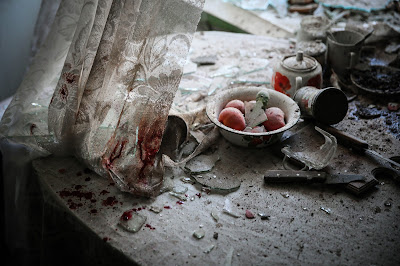Montreal World Press Photo 15
August 26- September 27, 2015
As in previous years, the Montreal World Press Photo 15 is held at the Bounsecure market (Marché Bonsecours), in Old Montreal. The exhibition presents photos that were awarded a special merit by the World Press Photo jury this year. There are many such photos on display; each visitor is bound to find a favourite one.
Above and just below are two areal photos of the exhibition's display set up. The photos are grouped by various categories like General News, Contemporary Issues, Daily Life, Nature, Portraits and Sports.
The photo below won First Prize General News Category, Singles. It was taken by Sergei
The photo just below, by Massimo Sestini, Italy, merited the Second Prize General News Category, Single. It depicts shipwrecked people rescued by a frigate of the Italian navy 20 miles north off the coast of Libya. After hundreds of men, women and children had drowned in 2013 off the coast of Sicily and Malta, the Italian government put its navy to work under a campaign called “Mare Nostrum” rescuing refugees at sea. Only in 2014, 170,081 people were rescued and taken to Italy. It has a clear-cut and simple composition that is very effective. Furthermore, the boat is in a shape of a bullet, with the waves making it look like a bullet flying through the air, and this is what the refuges are fleeing from - from the real life bullets.
The next photo below truly has a feel of a painting. It must have been photoshopped to give it such a stunning visual and colour effect. It won the Second Prize in the category Long-Term Projects and it is by Kacper Kowalski, Poland. It looks like a wide opened eye of the nature starring at us.
This is what the caption to the Kowalki's photo states:
54°33’47.37”N 18°13’42.22”E. Kacper Kowalski is a pilot and a photographer. Side Effects is a documentary project about the complex relationship between humans and nature. The photos were shot either from a paraglider or a gyroplane, some 150 meters above the ground, mainly in the area around
The camera is never connected to a remote control, and
Kowalski never uses a drone. He wants to be up there, camera in hand. And he
flies alone. That means he doesn’t have to explain anything, or rely on another
person’s spatial imagination. It means he can fly precisely. Side Effects
is more a method of visual storytelling than a concrete set of pictures. It is
an ongoing project that will continue to be modified.
The above photo won the Second Prize Nature Category, Singles. It is by Ami Vitale , USA Lewa Downs , Northern Kenya. It has a high artistic interest in regard to repeated patterns and colour highlights. Notice how the semicircle of the hands completes the semicircle of the rhino head to make an elliptical shape which is further enhanced by the semicircle of the grass edge below the animal's head and that of the bracelets above. It is really a great composition. It is not clear though whether the rhino was shot or only tranquillized, or was it trained to lie down and don't move. Even the caption and story do not tell us this.
The caption reads: A group of young Samburu warriors encounter a rhino for the
first time in their lives. Most people in Kenya
Story: organized by sophisticated, heavily armed criminal networks and
fuelled by heavy demand from newly minted millionaires in emerging markets,
poaching is devastating the great animals of the African plains. Much needed
attention has been focused on the plight of wildlife and the conflict between
poachers and increasingly militarized wildlife rangers, but very little has
been said about the indigenous communities on the front lines of the poaching
wars and the work that is being done to strengthen them. These communities hold
the key to saving Africa ’s great animals.
Plan to attend the Montreal's World Press Photo 15. For more information, consult their website here.
Click on images to enlarge them.
Three top photos by Nadia Slejskova.
Five images of photos on display at the Montreal's World Press Photo 15 exhibition courtesy of World Press Photo.








No comments:
Post a Comment